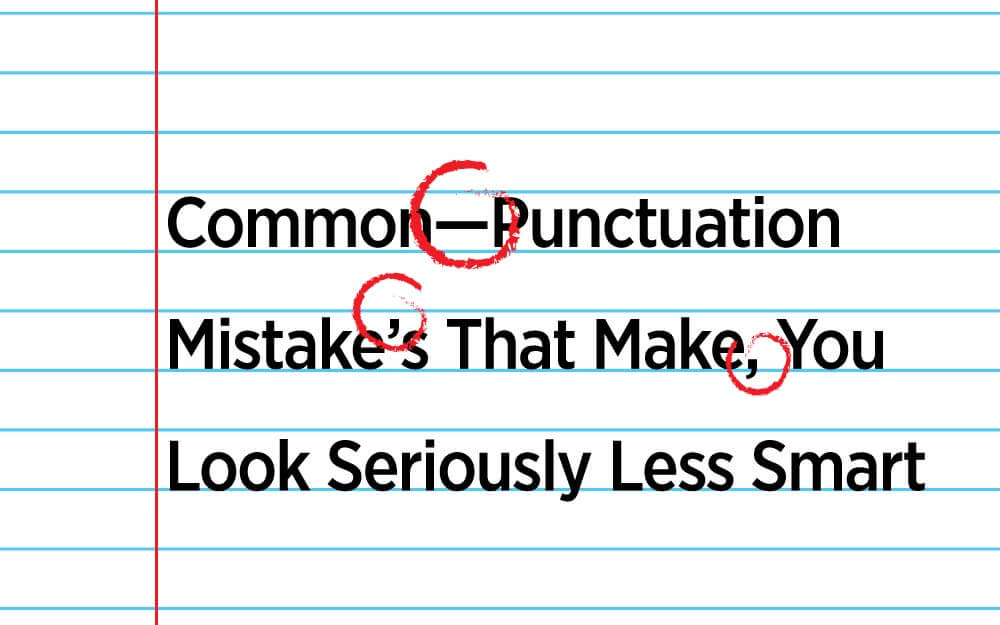Words are a powerful mode of communicating your thoughts, your ideas, and your products and services (if you are in business). The efficacy of your idea depends on the kind of marketing you do- the jingles, the slogans, and the catch phrases you use. While writing down these ideas or your next selling point in the form of an advertisement, it is extremely important to utilize correct punctuation.

A well-written marketing slogan may or may not boost your business, but incorrect punctuation will certainly damage your prospects. Customers are usually very pedantic and the moment they catch a mistake, it becomes a judging point for them and they are less likely to trust you. Moreover, it also reflects badly on your message so it is best to avoid making such mistakes as much as possible.
Here are 8 common punctuation mistakes and how you can easily avoid them:
1. Colons and Semi-colons
Semi-colons are often used in place of colons. For example, when you have to list out some items-
I purchased three items; a toothpaste, a brush, and a blanket (Wrong)
I purchased three items: a toothpaste, a brush, and a blanket (Correct)
Remember, semi-colons are used to link two independent clauses i.e. two separate but related thoughts.
2. Placement of Quotation Marks
This is quite confusing because American and British English follow different rules. Usually, a sentence-ending punctuation should be inside the quote, because that is part of the sentence being quoted. Let’s see an example:
“I had a wonderful day at work!” (American style)
“I had a wonderful day at work”! (British style)
It is up to you what style you prefer, but don’t use both of them.
3. Hyphen vs Dash
This is a hyphen à (-)
This is a dash à ( — )
A hyphen is used to combine two words to create a single idea (mostly an adjective), while a dash (used with spaces before and after) indicates that you are moving to a different train of thought.
For example:
The building is made of high-grade aluminum (use of hyphen)
I really like vanilla flavor – it is much tastier than chocolate (use of dash)
Note the use of spaces in a hyphen (no space) and a dash (space before and after).
4. Excess exclamation
An exclamation mark is used to emphasize on a certain point and make the reader excited about it. Using too many exclamation marks becomes overwhelming to read and people can dismiss you as a puerile, over-excited person.
For example:
This is the best course you should enroll in! You will immensely benefit from it! Sign up today!
OR
Get our products at 50% off!!!
Both cases above have excess exclamation marks that should be avoided.
5. Use of Apostrophes
Many people use extra apostrophes, thus making a mess of the sentence. This arises from improper understanding. Remember, plurals generally don’t require an apostrophe but the possessive forms usually do.
For example:
The bowlers’ had a good night partying out (Wrong)
The bowlers’ rooms were occupied by the batsmen (Correct)
6. Difference between its and it’s
A mistake made by most people. ‘It’s’ is the short from of it is while ‘its’ is the possessive form.
Whenever you use it in a sentence, just expand to it is and see whether the sentence makes sense or not.
Regarding ‘its’- this is a possessive pronoun. That means it is used when you have to mention ‘belonging to’ e.g. its feet were dirty. Or- the insurance of the car had expired, its paint had also faded.
Using it’s in the above case will not be correct, because it will mean “it is feet were dirty” and “it is paint had also faded”.
7. Too many commas, missing commas
When there is confusion regarding comma usage, there is a general tendency to use too many commas. For instance,
I went to the shop, but they were closed, so I went to the mall, and purchased an outfit, and went home.
People also remove commas altogether, making it seem that the sentence has been spoken hastily in a single breath.
For example,
I went to the shop but they were closed so I went to the mall and purchased an outfit and went home.
This sounds way worse than the one with a lot of commas.
The solution- speak out the sentence aloud and see where all the pauses seem appropriate. Use commas in those pauses.
8. Using the Oxford comma
When you have to describe more than two items in a sentence then a comma is used before and of the last item. You can understand the use of the Oxford comma better in this hilarious article.

